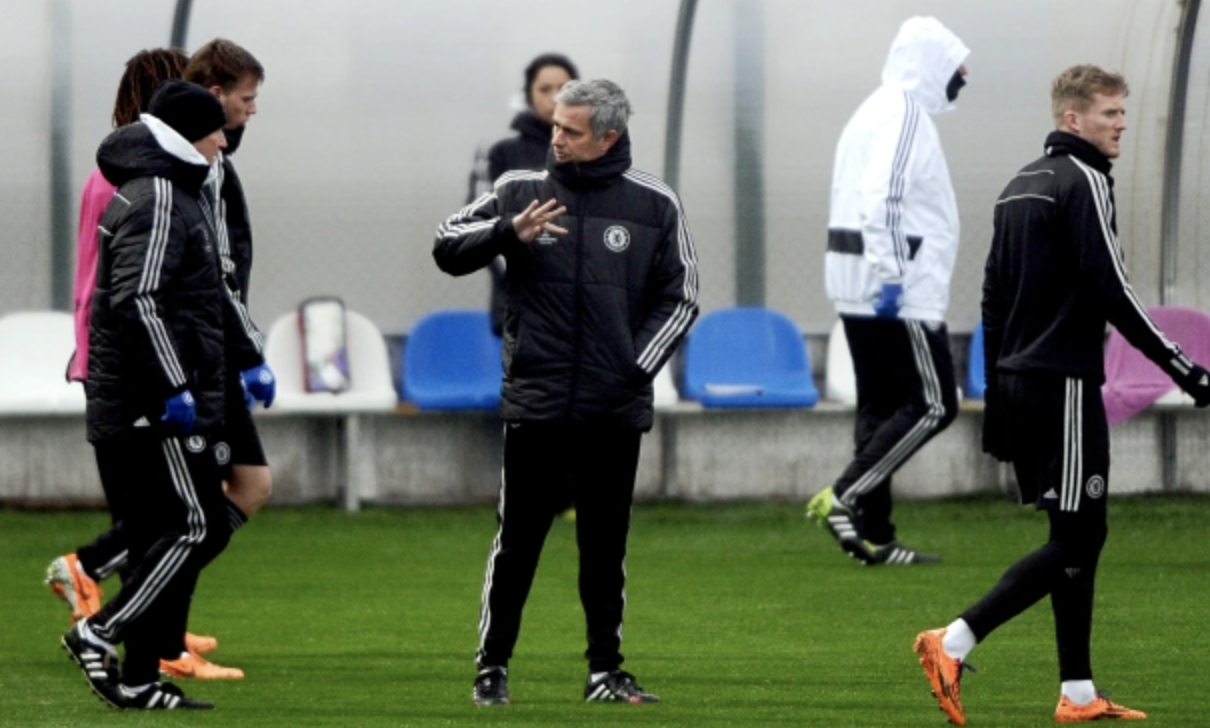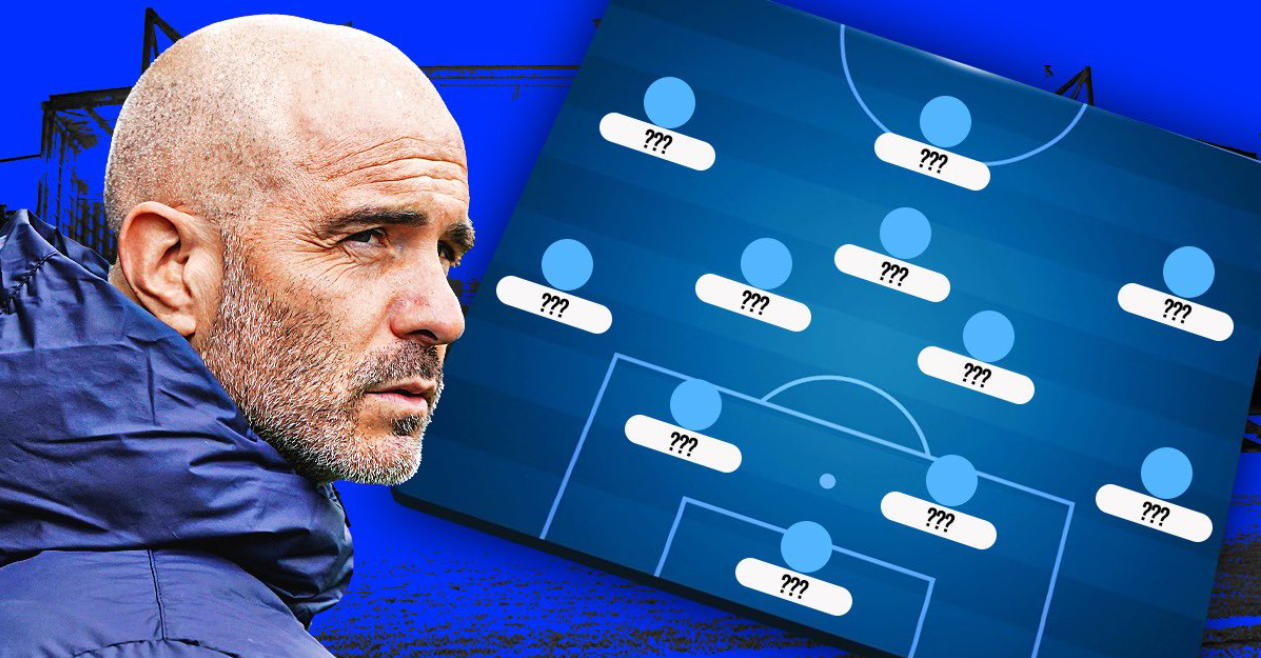The 4-3-3 has a special place in the annals of Chelsea Football Club’s history. A formation that Jose Mourinho brought with him to England to revolutionize the way a country saw league football .
England’s love for 4-4-2 wasn’t a well guarded secret , and no one in Britain was willing to question it. It actually stems from what was a 4-2-4 system used by great Brazilian and Real Madrid sides of the past, says former England coach Don Howe. English teams with weak wingers however preferred the diamond version, in which one player sat behind to protect the more attack minded players. The formation is self explanatory but the fascination was largely about how balanced it was. Two strikers upfront joined by two fullbacks and two of the midfielders who kept pushing up in a rotational basis to give the defenders a false sense of security .
Then came Mr.Félix and his notebook. In his own words – ‘Look, if I have a triangle in midfield – Claude Makelele behind and two others just in front – I will always have an advantage against a pure 4-4-2 where the central midfielders are side by side. That’s because I will always have an extra man. It starts with Makelele, who is between the lines. If nobody comes to him he can see the whole pitch and has time. If he gets closed down it means one of the two other central midfielders is open. If they are closed down and the other team’s wingers come inside to help, it means there is space now for us on the flank, either for our own wingers or for our full-backs. There is nothing a pure 4-4-2 can do to stop things’. It was revolutionary. Chelsea weren’t beautiful but they were dangerously efficient in dispatching the teams they faced them. In his first season at the club , Chelsea conceded only an astonishing 15 goals, but they also scored a woeful 15 goals less than Arsene Wenger’s second placed ‘we still believe in beautiful football’ Arsenal.
Drogba was bought in to bully the center-backs as the full-backs bombarded forward. With the addition of a lethal Frank Lampard in his prime and Damien Duff along with Arjen Robben tearing down the flanks, teams feared attacking them not cause they thought they wouldn’t be able to score, but because they didn’t want to be hit brutally and embarrassingly on the counter.
Jose was then faced with the problem of man marking, to which he devised another plan. If you were to switch your wingers across the field, it would lead to confusion that opposition defenders found hard to understand. Joe Cole and Arjen Robben were then preferred over Shaun Wright-Phillips and Damien Duff. Joe Cole was tactically revolutionized as a player by being given the same treatment that Mata had, but the one with his feet on the ground might have just won the battle as Arjen Robben blossomed into a player that strikes fear into the eyes of opposing full-backs.
Historically England has been rather blind to tactical innovation. The 4-2-3-1 that is now being hailed by English pundits as the formation to be used was infact in wide-spread use by the 2000’s in Spain. A certain English club was also using it but preferred to pass it off as another 4-4-2. When Manchester United beat Barcelona in the 1991 Cup-Winners’ Cup final, they used Bryan Robson and Paul Ince as the holding midfielders , Lee Sharpe and Mike Phelan as the widemen and Brian McClair performing as an unorthodox second striker (almost reminiscent to what is seen today as the #10 role) with Mark ‘Sparky’ Hughes playing upfront.
Interestingly the 4-2-3-1 was first noted in 1991 itself according to the magazine Training Football . The current Real Sociedad coach, Juanma Lillo , defending his club at the time Cultural Leonesa by explaining . My intention was to pressure and to try to steal the ball high up the pitch. It was the most symmetrical way I could find of playing with four forwards. One of the great advantages is that having the forwards high allows you to play the midfield high and the defence high, so everybody benefits. But you have to have the right players. They have to be very, very mobile and they have to be able to play when they get the ball. You have to remember that they’re pressuring to play, not playing to pressure.” Makes sense now right?
But the question I want to answer here is not even a question in the first place. It’s a possibility. Whether it’s a certain one or not, no one knows yet. 4-3-3 looks like it could make a return to Stamford Bridge, especially with the kind of players. Let’s delve into it a bit deeper and see the various ways we could use it effectively.
This is the team I largely expect if Jose was to field a 4-3-3. The back 4 would be the same no matter what the formation is because the possibility of Jose shifting to 3 at the back in his plan A seems unlikely. The right-back place is going to be quite controversial though, because as much as we expect Azpilicueta to start there, Jose loves a bit of Ivanovic. The advantages that the Serbian provides, Azpilicueta can’t. Having someone like Ivanovic, Terry and Cahill attacking a set-piece is an advantage in itself. Standing at 1.88m he’s the tallest full-back at Chelsea. Ashley Cole was 1.76m, Azpilicueta is 1.78m but Filipe Luis is 1.82m . We might as well see Azpilicueta starting if Luis manages to take the Serbian’s duty of being a huge threat at set-pieces.
We also need to talk about backups to the specific position because you can’t play the same team every game obviously.
There are many variations you could come up with, but it’s the tactical duties you need to look at. Highly discplined wing-backs, something Chelsea haven’t had since the days of Bridge, Gallas and Cole on the left with Geremi and Ferreira on the right. Then we have the most important bit, the triangle in the middle. Matic or whoever it is who plays in that role will have a huge role to play as he sits behind the defensive line. His role gets even more complicated when the full-backs are bombarding forward.
We have the two players who complete the triangle and I expect Fabregas to be the one who picks out the pass while Oscar is the one who scores. 4-4-2 was the most common used formation by the current Premier League teams in the last game they played. There were only two kinds of 4-3-3 used. Southampton and Arsenal’s version. Mauricio Pochettino used his midfielders to draw opposition defenders in and then use his full-backs to penetrate the open space, much like Jose did in his first spell. Arsene Wenger preferred his wide men to come in centrally to cause central overloads, and then to switch play.
In essence no other team has replicated Jose’s 4-3-3 system that was so successful .
We then have wingers that have the ability to switch positions. Willian, Schurrle and Hazard are well capable of it and the rotational midfield was seen in almost every game last season. Chelsea played a clear 4-3-3 only once last season.
 In the game against Southampton, Jose started out with a 4-2-3-1. The game was being won by Soton in the middle and when Oscar went off injured, on came Lampard to calm things down. But when players didn’t play in the way he wanted to, he shifted to a 4-4-2 at half time. Essien came off for Demba Ba and we saw Jose being reactive. Chelsea became more direct with long balls being plummeted up-field only to go through Southampton’s effective pressing style that was causing way too many problems for a rather slow Chelsea midfield. With the game put beyond doubt, thanks to Chelsea’s strength at set-pieces, Pochettino turned around his team to play a 4-4-2. Mourinho sensing danger, went vintage. He took of Torres and introduced Mikel to sit infront of the defense with Ramires and Lampard beside him. Chelsea saw the game out comfortably.
In the game against Southampton, Jose started out with a 4-2-3-1. The game was being won by Soton in the middle and when Oscar went off injured, on came Lampard to calm things down. But when players didn’t play in the way he wanted to, he shifted to a 4-4-2 at half time. Essien came off for Demba Ba and we saw Jose being reactive. Chelsea became more direct with long balls being plummeted up-field only to go through Southampton’s effective pressing style that was causing way too many problems for a rather slow Chelsea midfield. With the game put beyond doubt, thanks to Chelsea’s strength at set-pieces, Pochettino turned around his team to play a 4-4-2. Mourinho sensing danger, went vintage. He took of Torres and introduced Mikel to sit infront of the defense with Ramires and Lampard beside him. Chelsea saw the game out comfortably.
Over the years, 4-3-3 in terms of Chelsea, has turned into a rather negative option. As Chelsea’s average age went up, the speed went down. Despite having quick midfielders, you can still see a general lethargic-ness in moving the ball forward quickly. 4-2-3-1 has been the way to go, even for Jose. His 4-2-3-1 at Madrid was built around Ronaldo who was free of any defensive duties. Alonso completed the team as the deep-lying play-maker as Khedira allowed the team to play without shackles.
However going back to 4-3-3 isn’t the same as taking a shower and putting dirty underwear on. In Chelsea’s case, the formation will always hold a special place in the hearts of millions who found unbounded joy through it.









